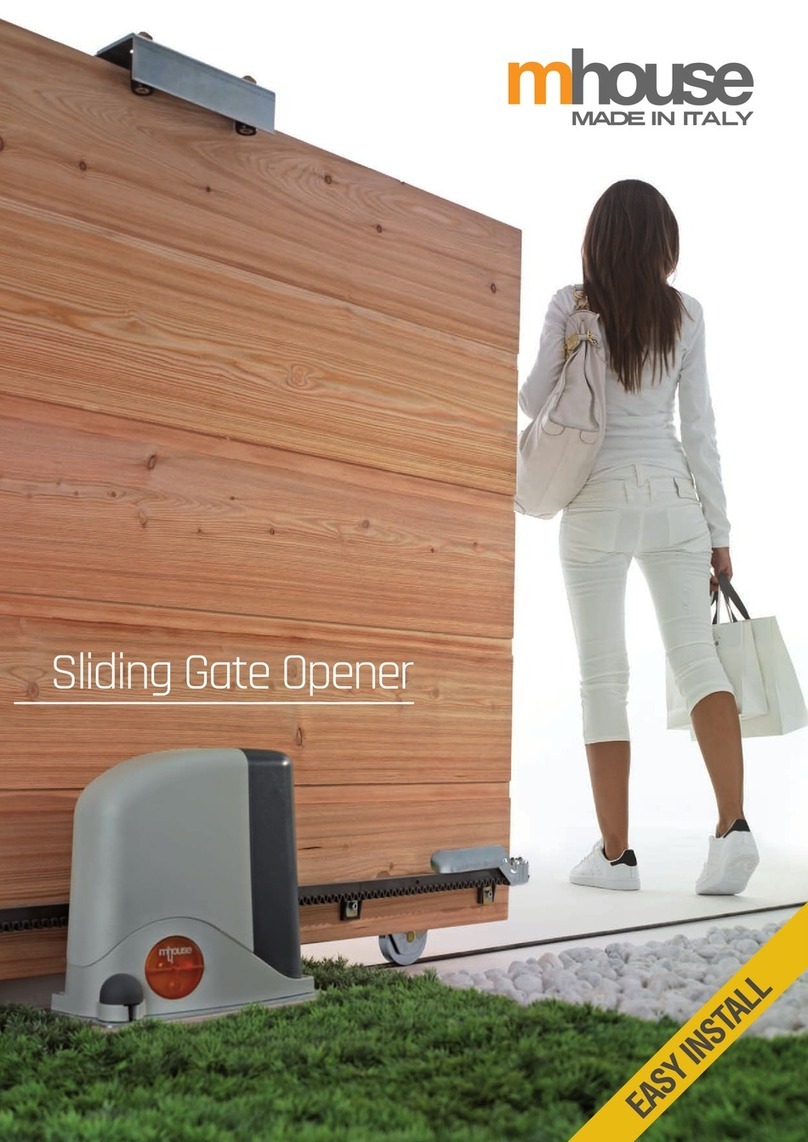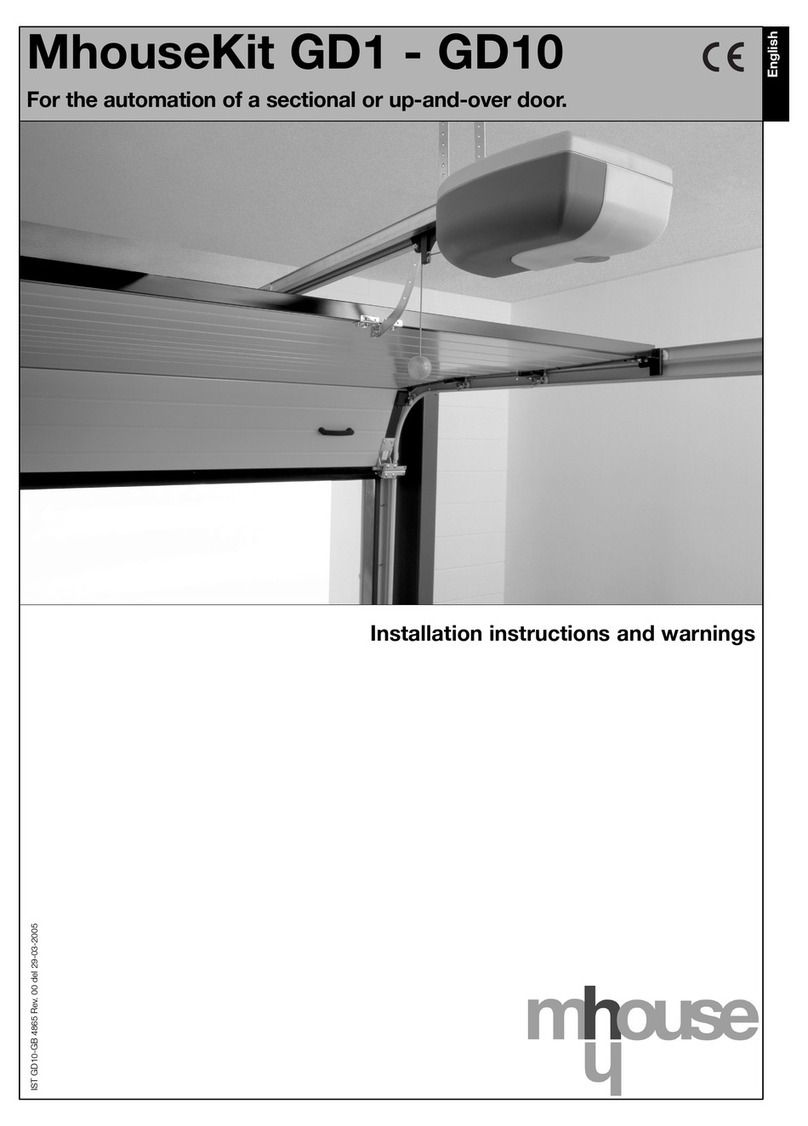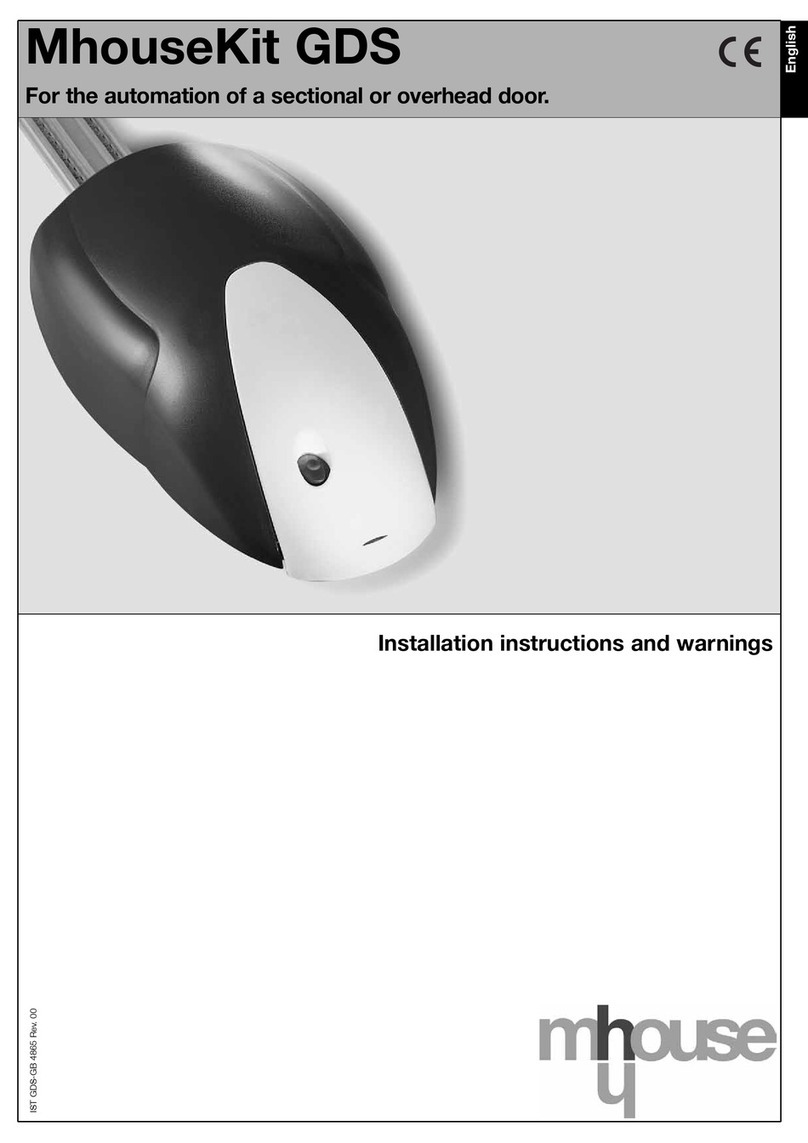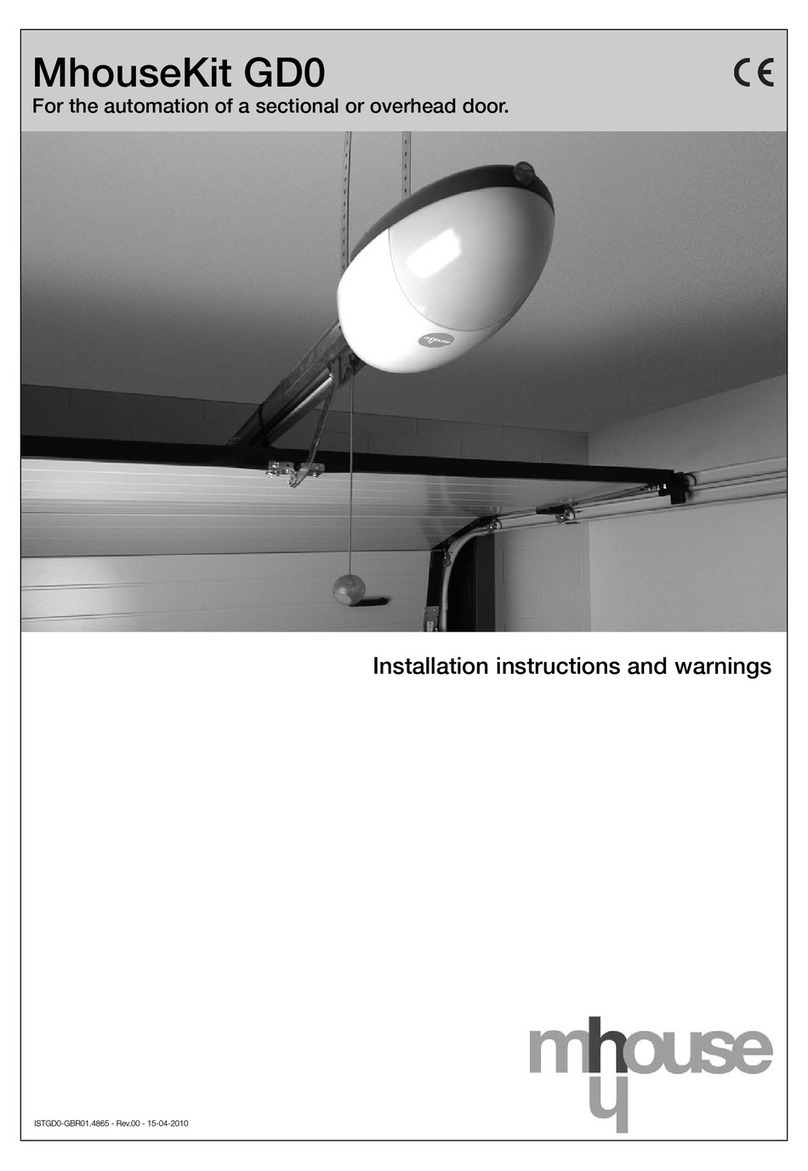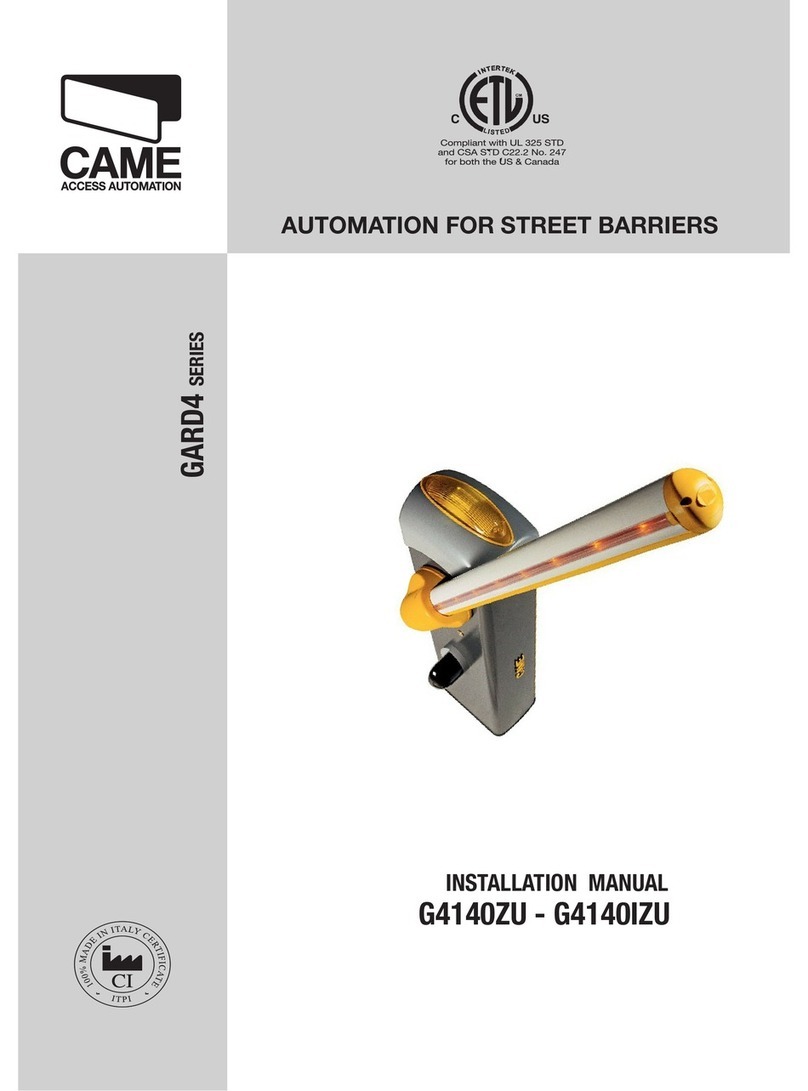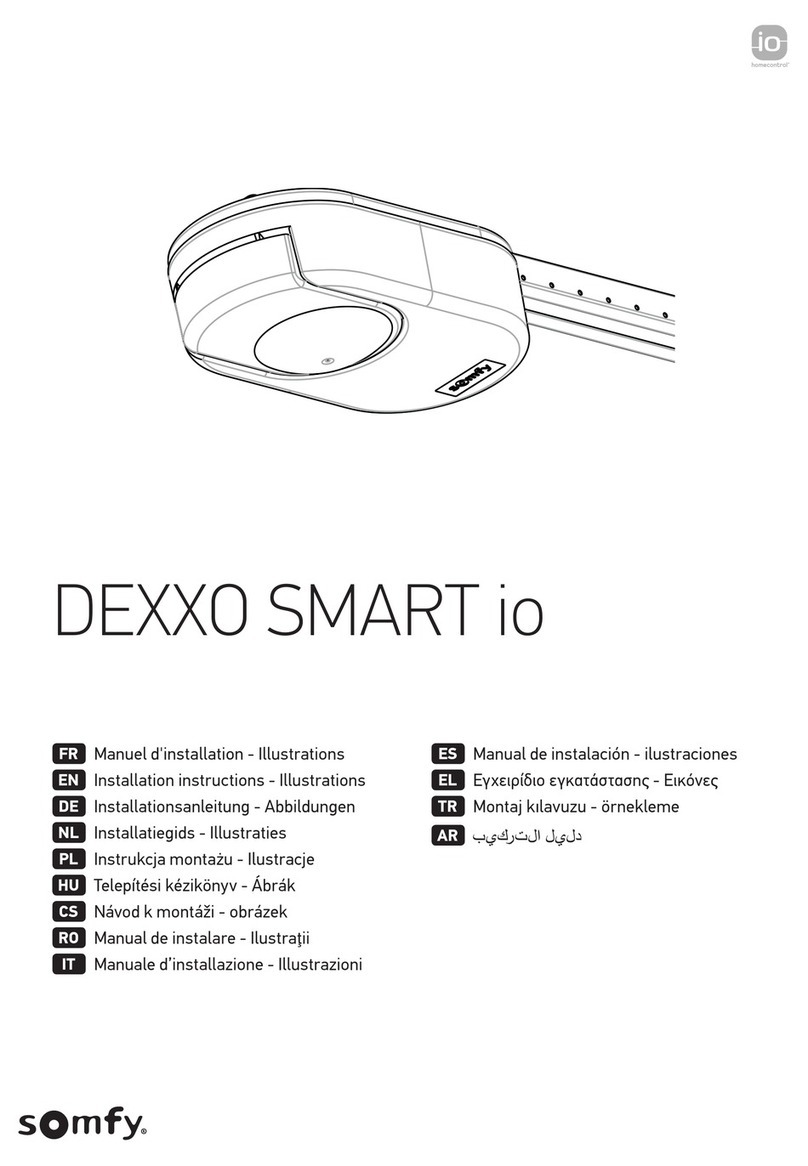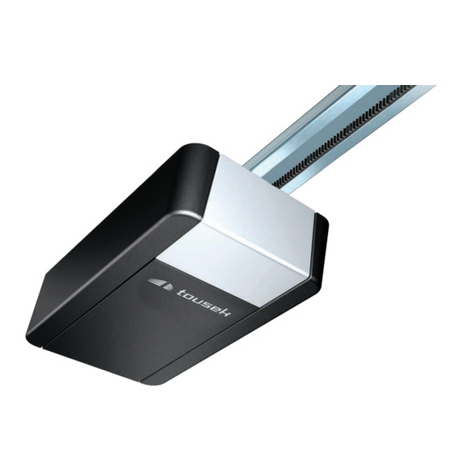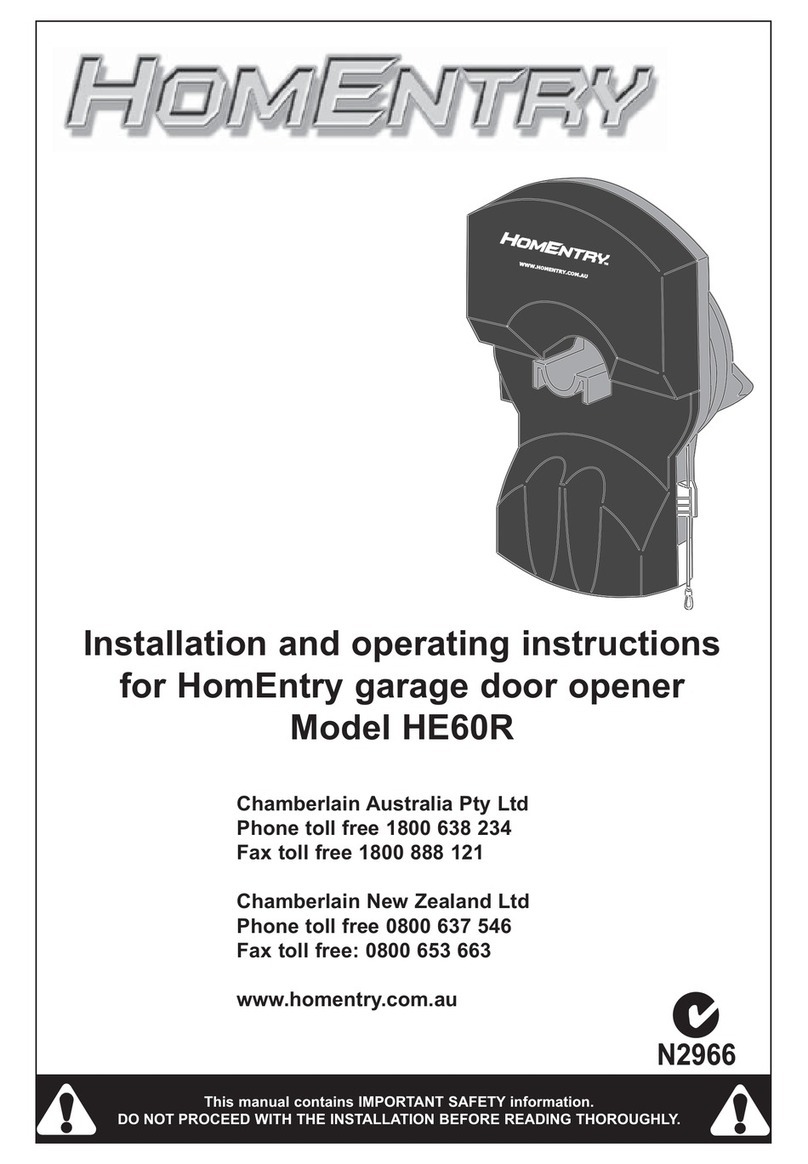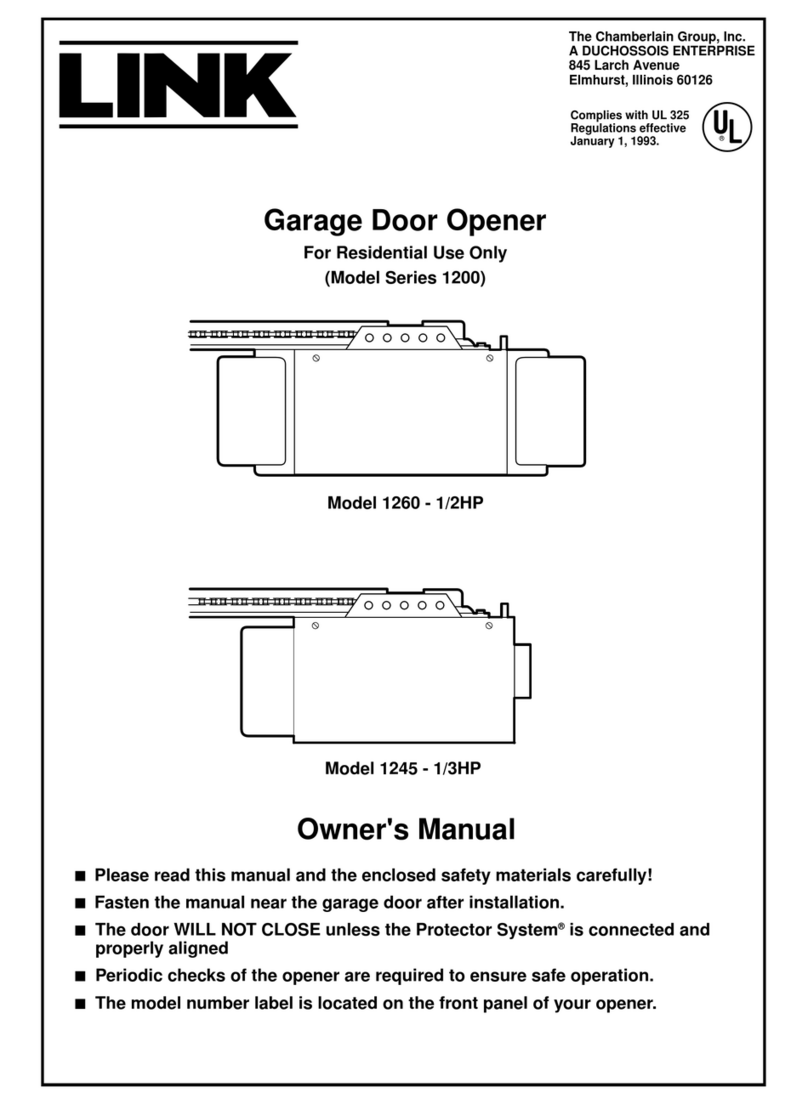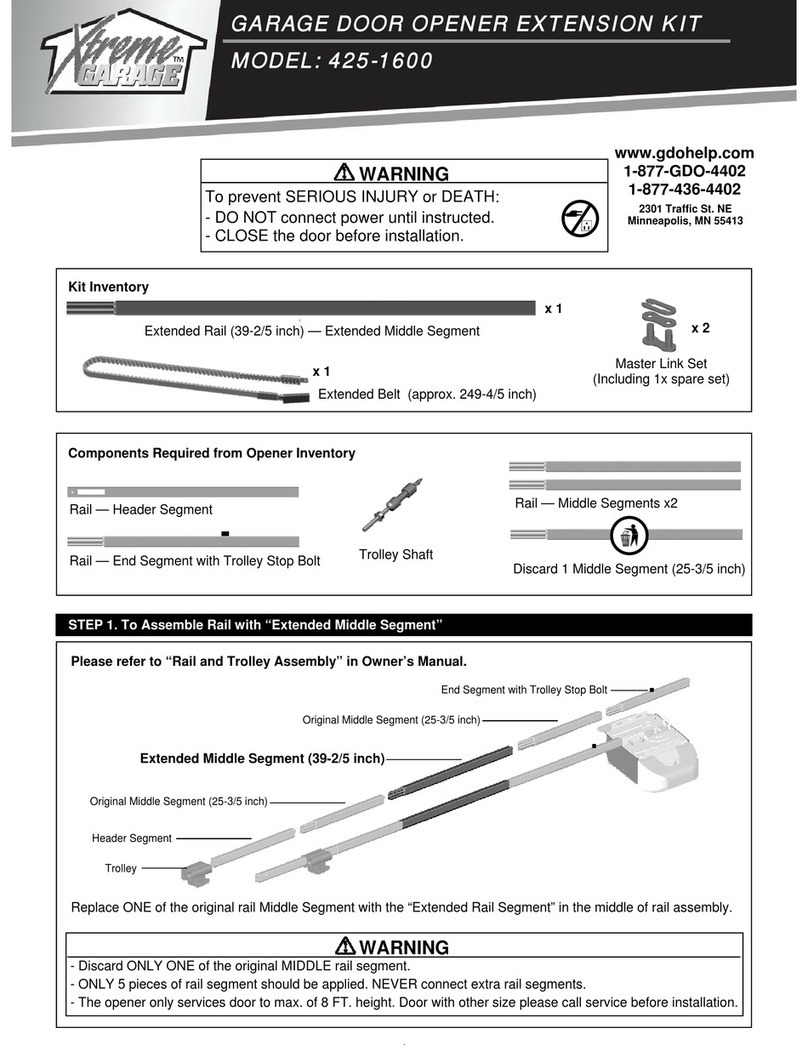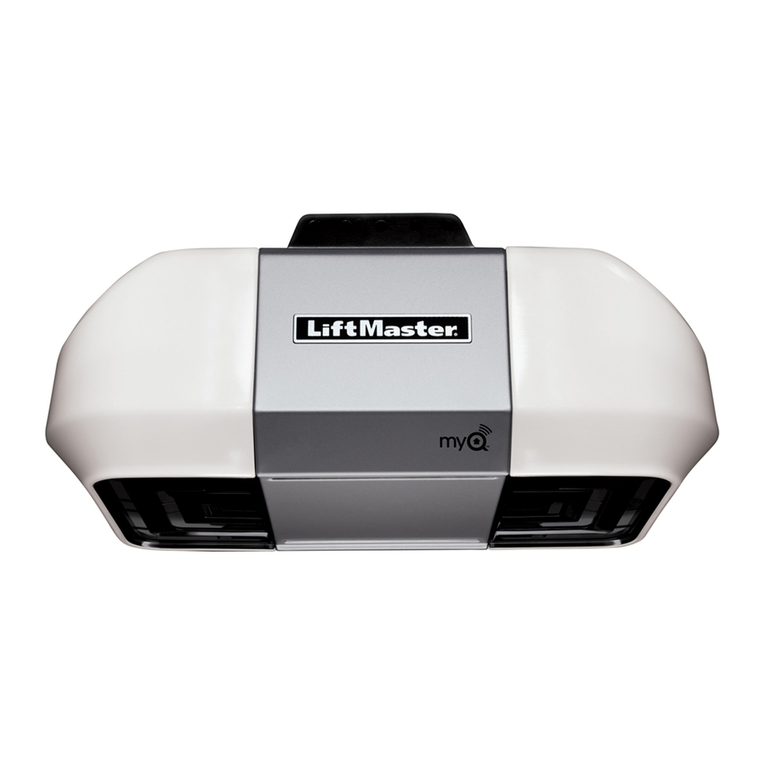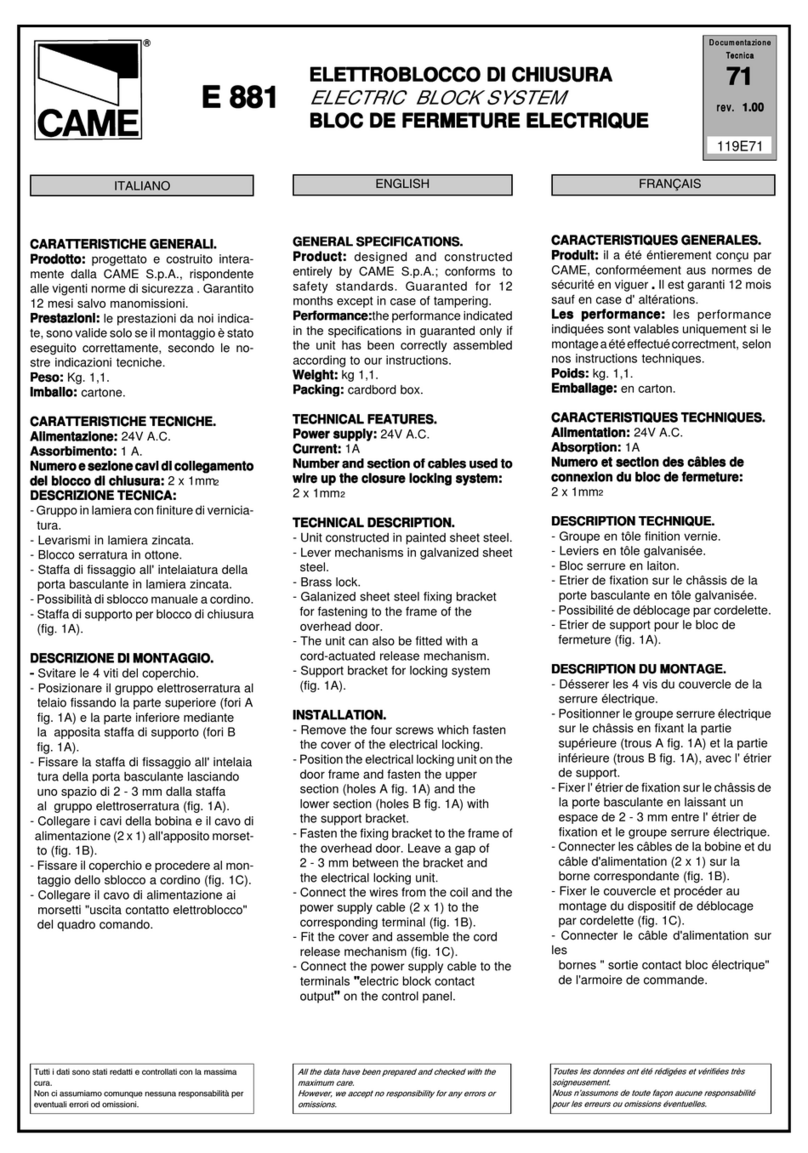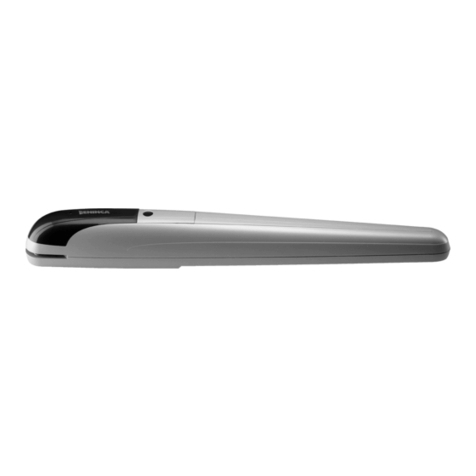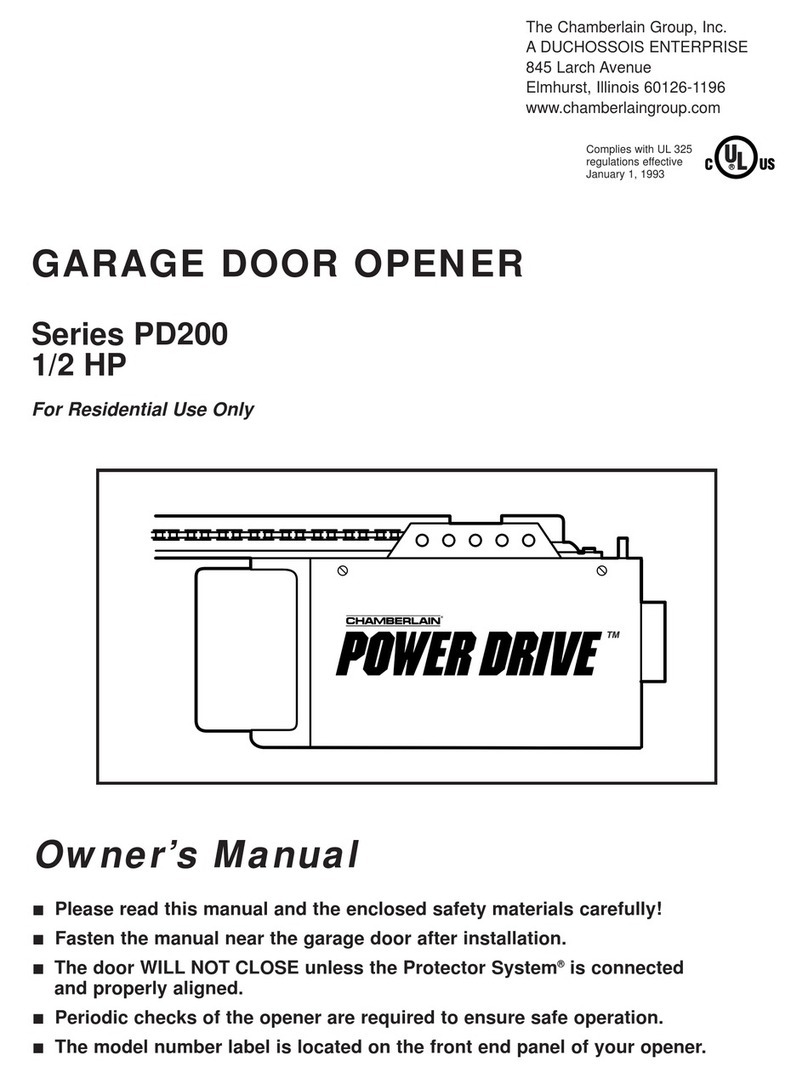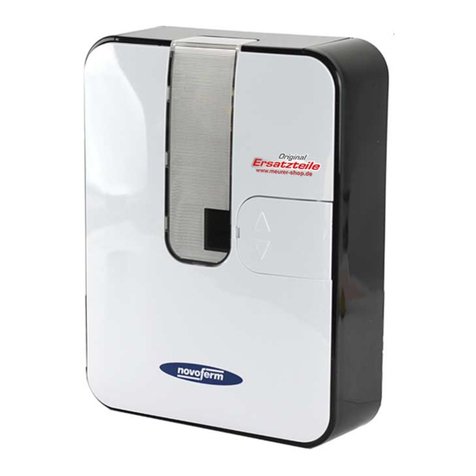Mhouse GDX01 Guide

MhouseKit GDX...
EN Installation and use instruc-
tions and warnings
IT Istruzioni ed avvertenze
per l’installazione e l’uso
FR Instructions et avertisse-
ments pour l’installation et
l’utilisation
ES Instrucciones y advertencias
para la instalación y
el uso
DE Anweisungen und Hinweise
für die Installation und die
Bedienung
PL Instrukcje instalacji i użytko-
wania i ostrzeżenia
NL Aanwijzingen en aanbevelin-
gen voor installering en
gebruik
Codice: ISTGDX01.4865 - Rev. 01 del 18-06-2007


GENERAL SAFETY WARNINGS AND
PRECAUTIONS
STEP 1
–Working in safety! 4
–Installation warnings 4
KNOWLEDGE OF THE PRODUCT AND PREPARATION
FOR INSTALLATION
STEP 2
2.1 - Product description and intended use 5
2.2 - Components used to set up a complete system 5
STEP 3
Preliminary checks for installation 6
3.1 - Checking suitability of the environment and door to be automated 6
3.2 - Checking product application limits 6
STEP 4
4.1 - Preliminary set-up work 7
- 4.1.1 - Typical reference system 7
- 4.1.2 - Establishing positions of components 7
- 4.1.3 - Establishing the device connection layout 7
- 4.1.4 - Checking the tools required for the work 7
- 4.1.5 - Completing the set-up work 7
4.2 - Laying the electric cables 7
INSTALLATION: COMPONENT ASSEMBLY AND
CONNECTION
STEP 5
5.1 - Installing the automation components 10
5.2 - Installing buffer battery mod. ME 12
5.3 - Fixing the automation to the wall, ceiling, and door 13
STEP 6
–System device installation and connection 15
POWER SUPPLY CONNECTION
STEP 7 17
INITIAL START-UP AND ELECTRICAL CONNECTIONS
CHECK
STEP 8 17
PROGRAMMING THE AUTOMATION
STEP 9
9.1 - Memorisation of transmitter mod. TX4 18
9.2 - Memorising the door “Opening” and “Closing” travel limit positions 18
DJUSTMENTS AND OTHER OPTIONAL FUNCTIONS
10 - Automation operation adjustment 19
11 - Memorisation of a new transmitter with control unit “in the vicinity” 19
12 - Deleting data from the Control unit memory 19
WHAT TO DO IF... (troubleshooting guide) 21
TASKS RESERVED FOR QUALIFIED TECHNICIANS
–Connecting the automation to the electrical mains 22
–Automation testing and commissioning 22
–Product disposal 23
TECHNICAL SPECIFICATIONS OF
COMPONENTS 24
Enclosures: “TECHNICAL DOCUMENTATION” I-VII
CONTENTS
English
English – 3

GENERAL SAFETY WARNINGS AND PRECAUTIONS
Technical documentation. This must be compiled by a professional
installer.
Considering the risk situations that may arise during installation
phases and use of the product, the automation must be installed in
observance of the following warnings:
– never make any modifications to part of the automation other than those
specified in this manual. Operations of this type will lead to malfunctions.
The manufacturer declines all liability for damage caused by makeshift
modifications to the product.
– ensure that parts of the automation cannot come into contact with
water or other liquids. During installation ensure that no liquids penetrate
the gearmotors or other devices present.
– Should this occur, disconnect the power supply immediately and con-
tact a Mhouse service centre. Use of the automation in these conditions
constitutes a hazard.
– never place automation components near to sources of heat and never
expose to naked flames. This may damage system components and
cause malfunctions, fire or hazardous situations.
– all operations requiring opening of the protection housings of various
automation components must be performed with the control unit discon-
nected from the power supply. If the disconnect device is not in a visible
location, affix a notice stating: “WARNING! MAINTENANCE IN
PROGRESS”.
– the product may not be considered an efficient system of protection
against intrusion.
If an efficient protection system is required, the automation must be inte-
grated with other devices.
– Connect the control unit to an electric power line equipped with an
earthing system.
– the product may only be used after completing the automation “com-
missioning” procedure as specified in paragraph “Automation testing
and commissioning”provided in the section “Tasks reserved for qualified
technicians”.
– The automation component packaging material must be disposed of in
full observance of current local legislation governing waste disposal.
STEP 1
WORKING IN SAFETY!
Please note - These instructions must be followed to
guarantee personal safety.
Please note – Important safety instructions. Keep for
future reference.
The design and manufacture of the devices making up the product
and the information in this manual fully comply with current stan-
dards governing safety. However, incorrect installation or program-
ming may cause serious physical injury to those working on or using
the system. For this reason, during installation, always strictly
observe all instructions in this manual.
If in any doubt regarding installation, do not proceed and contact the
Mhouse Technical Assistance for clarifications.
If this is the first time you are setting up an automation for garage doors
(sectional or up-and-over), we recommend that you read this entire man-
ual with care. This is preferable before any work, without any hurry to start
practical tasks.
Also keep product devices on hand while consulting the manual to enable
testing and checking (excluding any programming phases) with the infor-
mation provided in the manual.
While reading this manual, take care to observe all instructions
marked with the following symbol:
These symbols indicate subjects that may be the source of potential
hazards and therefore the prescribed operations must be performed
exclusively by qualified and skilled personnel, in observance of
these instructions current safety standards.
INSTALLATION WARNINGS
According to the most recent legislation, the installation of a garage
door must be in full observance of the standards envisaged by Euro-
pean Directive 98/37/EC (Machinery Directive) and in particular stan-
dards EN 12445, EN 12453 EN 12635 and EN 13241-1, which enable
declaration of presumed conformity of the automation.
In consideration of the above,
The final connection of the automation to the electrical mains, sys-
tem testing, commissioning and periodic maintenance must be per-
formed by skilled and qualified personnel, in observance of the
instructions in the section “Tasks reserved for qualified technicians”.
These personnel are also responsible for the tests required accord-
ing to the risks present, and for ensuring observance of all legal pro-
visions, standards and regulations , and in particular all requirements
of the standard EN 12445, which establishes the test methods for
checking automations for garage doors.
However, all preliminary set-up, installation and programming opera-
tions may be performed by personnel with standard skills, provided
that all instructions and the relative sequences in this manual are
strictly observed, with special reference to the warnings in STEP 1.
Before starting installation, perform the following checks and
assessments:
– ensure that each device used to set up the automation is suited to the
intended system. For this purpose, pay special attention to the data pro-
vided in the paragraph “Technical specifications”. Do not proceed with
installation if any one of these devices does not correspond to specifica-
tions.
– ensure that the devices in the kit are sufficient to guarantee system safe-
ty and functionality.
– an assessment of the associated risks must be made, including a list of
the essential safety requirements as envisaged in Appendix I of the
Machinery Directive, specifying the relative solutions adopted. Note that
the risk assessment is one of the documents included in the automation
English
4– English

STEP 2
2.1 – PRODUCT DESCRIPTION AND INTENDED USE
In general, the series of devices that make up this product serve to auto-
mate a garage door for residential applications (fig.1). This type may be
“sectional” or “up-and-over”; up-and-over doors may be projecting (dur-
ing opening the door protrudes outwards) or non-projecting with springs
or counterweights.
In particular, this kit is designed for the automation exclusively of sectional
garage doors. Therefore, to automate an up-and-over door, the special
oscillating arm must be fitted (mod. GA1, not supplied in pack).
Any other use than as specified herein or in environmental condi-
tions other than as stated in STEP 3 is to be considered improper
and is strictly prohibited!
This product (GDX - GDXP - GDXR - GDXPR) comprises an electro-
mechanical gearmotor with a 24 V dc motor, a guide, chain and a drive
carriage. The gearmotor is also equipped with a control unit.
The control unit comprises an electronic board, a courtesy/indicator light
and a built-in radio receiver, plus an aerial, which receives the commands
sent by a transmitter.
The control unit can control different types of manoeuvres, each program-
mable and usable according to specific requirements.
Special functions are also available to enable personalisation of automa-
tion operation.
The automation is designed for use with various accessories which
enhance functionality and guarantee optimal safety. More specifically, the
control unit can memorise up to 150 keys of transmitters mod. TX4 and
up to 4 pairs of photocells, mod. PH0.
The product is mains-powered, and, in the event of a power failure
enables manual movement of the door, by release of the drive carriage
using a special cord or by means of a release mechanism located exter-
nally (mod. GU1, not supplied in pack).
In any event the door can also be opened by means of a buffer battery
(mod. ME, not supplied in pack) if fitted on the system.
KNOWLEDGE OF THE PRODUCT AND PREPARATION FOR INSTALLATION
1
2.2 – COMPONENTS USED TO SET UP A
COMPLETE SYSTEM
Fig. 2 illustrates all components used to set up a complete system, such
as that shown in fig. 8.
List of components:
[a] - electromechanical gearmotor
[b] - guide for carriage in 3 parts + joining brackets
(only for mod. GDX and GDXP)
[c] - integral guide (only for mod. GDXR and GDXPR)
[d] - gearmotor ceiling mounting brackets
[e] - gearmotor wall-mounting brackets
[f] - mechanical stop for carriage travel limit
[g] - chain gear
[h] - drive chain
[i] - drive carriage
[l] - automation release knob and cord
[m]- door drive rod (for sectional doors only)
[n] - bracket for connection of drive rod to door
[o] - oscillating arm and relative drive rod
(mod. GA1, for up-and-over doors only)
[p] - pair of photocells (wall-mounted) mod. PH0
[q] - transmitter (portable) mod. TX4
[r] - radio control keypad mod. DS1 (wall-mounted)
[s] - two buffer batteries mod. ME (only for mod. GDXR and GDXPR)
[t] - Metal hardware (screws, washers, etc.)*
[u] - external release kit mod. GU1
(*) Note – The screws required for wall-fixture of components are not
included in the pack, as their type depends on the material and thickness
of the door in which they are inserted.
WARNING!
Some components shown in fig. 2 are optional and may not be
supplied in the pack.
SECTIONAL PROJECTING NON-PROJECTING
English
English – 5

STEP 3
PRELIMINARY INSTALLATION WORK
Before proceeding with installation, check the condition of the product
components, suitability of the selected model and conditions of the
intended installation environment.
IMPORTANT – The gearmotor cannot be used to power a door
that is not fully efficient and safe. Neither can it solve defects
caused by poor installation or insufficient maintenance of the
door itself.
3.1 – CHECKING SUITABILITY OF THE ENVIRONMENT
AND THE DOOR TO BE AUTOMATED
• In the case of automating a projecting up-and-over door, ensure that
movement does not obstruct public roads or pavements.
• Ensure that the mechanical structure of the door is suitable for automa-
tion and complies with local standards.
• Check stability of the mechanical structure of the door, ensuring that
there is no risk of guides coming out of their seats.
• Move the door manually to open and close, checking that movement
has the same degree of friction throughout all points of travel (no increase
in friction must occur).
• Ensure that the door is correctly balanced: in other words, if left station-
ary (manually) it must not move from any position.
• Ensure that the space around the automation enables safe and easy
manual release.
• Ensure that the selected surfaces for installation of the various devices
are solid and guarantee a stable fixture.
• Ensure that all devices to be installed are in a sheltered location and pro-
tected against the risk of accidental impact.
• Ensure that the selected surfaces for fixing the photocells are flat and
enable correct alignment between photocells.
3.2 – CHECKING PRODUCT APPLICATION LIMITS
To ascertain suitability of the product with respect to the specific features
of the door and area to be automated, the following checks should be
performed as well as a check for compliance of the technical data in this
paragraph and the chapter “Product technical specifications”.
• Ensure that the dimensions and weight of the door are within the follow-
ing limits of use:
model GDX and GDXP
– Sectional doors: maximum width 350 cm; maximum height 212 cm;
maximum movement force 500 N.
– Projecting up-and-over doors: maximum width 350 cm; maximum
height 260 cm; maximum movement force 500 N.
– Non-projecting up-and-over doors: maximum width 350 cm; maxi-
mum height 212 cm; maximum movement force 500 N.
model GDXR and GDXPR
– Sectional doors: maximum width 350 cm; maximum height 240 cm;
maximum movement force 500 N.
– Projecting up-and-over doors: maximum width 350 cm; maximum
height 280 cm; maximum movement force 500 N.
– Non-projecting up-and-over doors: maximum width 350 cm; maxi-
mum height 220 cm; maximum movement force 500 N.
English
6– English
2
ab c d
ef ghi
lmnop
qr s t u

4
B
F
5
G
M
D
3
B
E
A
D
Note – The shape of the door and weather conditions, such as the pres-
ence of strong winds, can reduce the above maximum values. In these
cases it is important to measure the force required to move the door in the
worst conditions and compare these with the technical specifications of
the gearmotor.
• Ensure that the area for mounting the gearmotor and guide is compati-
ble with the overall dimensions of the automation to be installed. Then
ensure that the minimum and maximum clearances can be observed as
shown in fig. 3, 4 and 5.
Caution! – If the results of these checks do not conform to spec-
ifications, this model cannot be used to automate your door.
STEP 4
4.1 – PRELIMINARY SET-UP WORK
4.1.1 – Typical reference system
Fig. 6, 7, 8 provide an example of an automation system set up with the
components compatible with this product. These parts are positioned
according to a typical standard layout. The following components are
used:
a- Electromechanical gearmotor
b- Carriage sliding guide
c- drive carriage
d- mechanical stop for carriage travel limit
e- carriage manual release knob
f- bracket for connection of carriage to door
g- pair of photocells (wall-mounted) mod. PH0
h- radio control keypad (wall-mounted) mod. DS1
i- portable transmitter mod. MT
l - Pushbutton
4.1.2 – Establishing positions of components
With reference to figs. 6, 7, 8, locate the approximate position for
installation of each component envisaged in the system.
4.1.3 – Establishing the device connection layout
With reference to fig. 10 and STEP 6establish the connection layout for
all system devices.
4.1.4 – Checking the tools required for the work
Before starting installation, ensure that there is all equipment and materi-
als required for the work concerned (see example in fig. 9); also ensure
that all items are in good condition and comply with local safety stan-
dards.
4.1.5 – Preliminary set-up work
Dig the routes for the ducting used for electrical cables, or alternatively
external ducting can be laid, after which the pipelines can be embedded
in concrete and other preparation work for the installation can be com-
pleted to finalise the site ready for subsequent installation operations.
CAUTION! – Position the ends of the ducting used for electrical
cables in the vicinity of the points envisaged for fixture of the various
components.
Notes:
• The ducting serves to protect electrical cables and prevent accidental
damage in the event of impact.
• The “fixed” control devices must be visible from the door but positioned
far from moving parts and at a minimum height of 150 mm.
4.2 – LAYING THE ELECTRIC CABLES
With the exception of the system connection to the mains by means of
the plug and socket, the rest of the system runs on very low voltage
(approx. 24 V) and therefore laying of electric cables may be performed by
personnel with standard skills, provided that all instructions in this manual
are strictly observed.
For laying electric cables, refer to fig. 10 specifying the type of cable to be
used for each connection.
WARNINGS:
– While laying the electrical cables, do NOT make any electrical con-
nections.
– Arrange for a qualified electrician to install a Shuko 16 A socket,
suitably protected, for insertion of the gearmotor power plug. The
socket must be positioned so that after connection of the power
cable plug, the cable does not hang in the vicinity of mobile parts or
hazardous areas.
from 65 to 100 mm
English
English – 7

English
8– English
7
8
6
a
b
c
d
l
e
f
h
m
g
g

English
English – 9
10
9
A
A
A
B
A
C
Note 1 – The cables required for the set-up of the system (not included in the pack) may vary according to the quantity and type
of devices envisaged for the installation..
Note 2 – The connections to terminals 1-2 (Stop), 4-5 (Step-step) and 3-5 (Photo) can be made using a single cable with several
internal wires.
CAUTION!– The cables used must be suited to the installation environment; for example a cable type H03VV-F for indoor envi-
ronments is recommended.
Technical specifications of electric cables (note 1)
A
B
C
Devices
Safety
photocells
Control
pushbutton
Safety pushbutton
– sensitive edges –
etc.
Terminals
3 - 5
3 - 4
1 - 2
Maximum admissible length
20 m (note 2)
20 m (note 2)
20 m (note 2)
20 m (note 2)
Function
PHOTO input
Input
STEP-STEP
STOP Input
Cable type
TX Cable 2 x 0,25 mm2
RX Cable 3 x 0,25 mm2
Cable 2 x 0,25 mm2
Cable 2 x 0,25 mm2

04.Use two screws to secure the ends of the chain into the groove on
the carriage plate (fig. 14).
05.Fit the spring on the support supplied (fig. 15-a) and insert the
assembly in the carriage plate (the plate not used to secure the
chain) (fig. 15-b).
06.Join the two carriage plates; insert the screw in the support of the
drive pulley; position the drive pulley in the chain and mount the
assembly onto the drive bracket with the pin supplied (fig. 16).
07.Insert the chain and carriage inside the guide, taking care to observe
the following:
Fig. 17-a) position the side of the carriage with the chain fixed with
the screws on the same side as the contro unit cover;
Fig. 17-b) position the carriage to approx. mid-way on the guide.
08.Pass the chain around the pinion of the gearmotor and close the
assembly with the protection cover (fig. 18).
09.Insert the bracket on the end of the guide and secure the two ele-
ments by means of a nut and washer (fig. 19).
STEP 5
5.1 – INSTALLING THE AUTOMATION COMPONENTS
WARNINGS
• Incorrect installation may cause serious physical injury to those
working on or using the system.
• Before starting automation assembly, make the preliminary checks
as described in STEP 3.
After laying the electric cables, proceed with assembly of the mechanical
parts of the guides and gearmotor, in the sequence specified below.
01. Only for models GDX and GDXP: using a mallet, securely join the
three guide sections inside the two joining brackets (fig. 11).
Important – the guides must slide inside the brackets until they click
firmly into place.
02.Insert the guide in the seat on the gearmotor (fig. 12).
03.Insert the travel limit mechanical stop (a) in the guide and move it
close to the gearmotor; then position plate (b) onto the stop and
secure the assembly by means of a screw (fig. 13). Note – The
screw must NOT be tightened excessively as the limit stop must
later be moved to its final position.
INSTALLATION: COMPONENT ASSEMBLY AND CONNECTIONS
11
12
13
V6 x 30
R06 (open) b
a
14
15-a
15-b
V3,5 x 15
16 V8 x 45
English
10 – English

11.
12.CAUTION! – If the door is up-and-over, use the drive rod sup-
plied with the oscillating arm for this operation.
Before fitting the drive rod, cut this to a length that ensures obser-
vance of recommended distance E shown in fig. 3. Then use screws
and nuts to secure one end of the drive rod to the bracket (the one to
be fixed to the door or oscillating arm) and the other end to the car-
riage (fig. 22).
FOR UP-AND-OVER DOORS ONLY
If the door to be automated is “up-and-over” (projecting or non-
projecting - fig. 1), the oscillating arm mod. GA1 must be fitted
(fig. 21). Then proceed with assembly of the various arm compo-
nents. IMPORTANT – Take care to move the arm as close as
possible to the handle of the door.
For assembly of the drive rod, refer to point 12.
Note – for assembly of the accessory, follow the instructions sup-
plied in the pack.
10.Tension the chain by tightening the nut on the screw of the drive
bracket (fig. 20). CAUTION – if the chain is tensioned excessive-
ly, this may cause excessive stress and damage the gearmotor;
if under-tensioned this may cause unpleasant noise.
18
21
19
M8
R8 x 24
V8 x 45
20 22
M6
V6 x 18
17-a
17-b
English
English – 11

13.Fix one end of the manual release cord to the carriage and the other
end to the knob (fig. 23). Note – Ensure that the manual release
knob is positioned at a maximum height of 180 cm from the ground.
14.• If the door is SECTIONAL: establish the length of distance Bcon-
sidering the constraints of values Aand E (fig. 24-a).
• If the door is UP-AND-OVER: establish the length of distance B
considering the constraints of value F(fig. 24-b).
Note – If values A, E or F allow, the automation can also be fixed
directly onto the ceiling (minimum 4 mm).
15.Fold the two ceiling mounting brackets to an “L” and mount in the
vicinity of the gearmotor, by means of screws and nuts (fig. 25).
Note – choose the most suitable hole on the brackets to observe
distance Bselected in point 14.
IMPORTANT! – Perform the operations below the door CLOSED.
5.2 – INSTALLING THE BUFFER
BATTERIES mod. ME
The buffer batteries are self-charging with a voltage of 12V and power of
0,8 Ah. These are particularly useful in the event of a sudden power failure.
The gearmotor enables installation of 2 batteries.
In general, when charged, the batteries guarantee an autonomy of
approx. 6 - 7 consecutive movement cycles (1 cycle = opening -closing)
This value can vary according to the type and weight of door.
To install the buffer batteries, proceed as follows:
01.Remove the screw of the control unit protection cover and remove
the cover (fig. 26).
02.Use a screwdriver to open the two cable routing slots (fig. 27).
03.Insert the battery cables in the cable routing slots (fig. 28) and posi-
tion each battery in the relative seat (fig. 29).
IMPORTANT – The batteries must be installed before mounting
the automation on the ceiling and wall.
23
26
27
28
24-a
24-b
25
A
D
E
B
F
B
V6 x 14
M6
B(4 ÷ 400 mm)
from 65 to 100 mm
English
12 – English

05.On the side of the control unit, insert the battery connectors in the
two sockets. CAUTION! – Do not invert polarity: the connector
grippers must face outwards (fig. 30).
On completion of installation, after powering up the system, the batteries
will start to self-charge and will be operative only when fully charged (usu-
ally after 12 hours).
WARNINGS
To guarantee optimal lifetime of the buffer battery, the following warnings should be
observed:
• The buffer battery is an emergency device: Therefore it should only be used mod-
erately in the event of real necessity. Excessive and continuous use can lead to
overheating of the elements, which over time may reduce the normal lifetime of the
battery.
• Never leave the automation powered exclusively by the buffer battery for periods
longer than a day: The elements may overheat excessively and impair lifetime of
the battery.
Therefore, if absent from the installation site of the automation for prolonged peri-
ods, it is recommended to detach the buffer battery terminal connected to the
control unit.
•When the buffer battery is completely discharged, around 24 hours are required to
completely recharge.
• In the event of prolonged periods of disuse, the optional battery should be
removed and stored in a dry location to avoid the risk of leaks of harmful sub-
stances.
–––––––––––––––––––
Battery disposal
CAUTION! – Even if discharged, the batteries can contain pollutant sub-
stances and therefore must never be disposed of in common waste col-
lection points. Dispose of according to separate waste collection methods
as envisaged by current local standards.
CAUTION! - The point below (05 – electrical connection of
the buffer battery to the control unit ) must only be per-
formed after completing all installation and programming
phases, as the battery is an emergency power source.
5.3 – FIXING THE AUTOMATION TO THE WALL,
CEILING, AND DOOR
After assembly of the guide and gearmotor, fix the automation to the wall,
ceiling and door as follows.
01.Using a suitable means of support (ladder, poles or similar) lift the
gearmotor from the ground an position at the required height so that
the guide brackets are placed against the ceiling and wall above the
door (fig. 31). IMPORTANT – (fig. 31-a) align the guide and gearmo-
tor with the vertical axis of the door and perpendicular to the latter
(90° angle). Note – In the case of up-and-over doors, the guide must
be aligned with the oscillating arm.
Also ensure observance of the values A, B, Ein fig. 3 and values B,
F in fig. 4.
02.Check the position of the guide, which must be perfectly horizontal,
and mark the 4 bracket fixture points, after which drill the relative
holes and insert the plugs (fig. 32).
03.Fix the automation to the ceiling and wall using screws and plugs
suited to the support material (fig. 33).
Notes:
• Depending on the type of wall, the bracket at the end of the guide
can be fixed by means of the rivets or screws and plugs.
• Take care when choosing the method of bracket fixture to the ceil-
ing, taking into account the following:
– the bracket at the end of the guide must withstand the force
required to open and close the door;
– the ceiling mounted brackets must withstand the weight of the
gearmotor.
In both cases possible wear and deformation over time must be tak-
en into account.
29
30
32
31
90°
31-a
English
English – 13

07.Move the travel limit mechanical stop up against the carriage.
Then tighten the travel limit mechanical stop screw fully down (fig. 37).
Note – During normal operation the carriage stops a few centimetres
before the mechanical stop.
08.To re-block the door, close it manually until it clicks firmly into place.
IMPORTANT
It is recommended to install
the external release kit
(model GU1), if the door
closes an area with no other
access points. In fact, in
this situation, a simple
power failure
may prevent access to the area.
Note – for assembly of the
accessory, follow the instructions
in its pack.
36
37
04.Use a saw to cut off the excess section of the ceiling-mounted
brackets (fig. 34).
05.(With the door closed) Pull the release knob and slide the carriage
until the anchoring bracket is positioned on the upper edge of the
sectional door, or until it reaches the connection of the oscillating arm
(up-and-over door). Then align the drive rod along the trajectory of
the guide and fix the bracket to the door using rivets or screws suit-
ed to the door material (fig. 35).
06.Slightly loosen the travel limit mechanical stop screw and manually
open the door until it reaches the maximum Opening position (fig. 36).
33
34
35
English
14 – English

STEP 6
SYSTEM DEVICE CONNECTION
After installing all devices in the system – each in the position specified in
STEP 4– connect each device to the control unit as follows.
CAUTION! – Incorrect connections can cause faults or hazards;
therefore ensure that the specified connections are strictly observed.
01. Use a screwdriver to loosen the screw on the control unit cover and
extract the cover (fig. 38), to access the terminals for electrical con-
nections of the control unit.
02. Use the same screwdriver to open the slots required for routing the
electric cables (fig. 39) from the various devices in the system.
03. Then connect the electric wires of the system devices to the control
unit using the terminal board with five terminals (fig. 39-a).
CAUTION – The section of electric cable connecting terminals 3
and 5 must only be removed if photocell installation is envis-
aged.
For correct connections, proceed as follows:
• To connect a pair of photocells with safety function
One or more pairs of photocells with a safety function must be installed on
the system. If several pairs of photocells are installed, these must be con-
nected in series, and the chain must be connected to terminals 3and 5
on the control unit. The connect the power supply to terminals 2and 3
(see example in fig. 40-a and fig. 40-b).
During the Closing manoeuvre, activation of these photocells causes
shutdown of the manoeuvre and immediate inversion of movement.
• To connect a NO type pushbutton used for manoeuvre control
An “NO” type pushbutton can be installed on the system, i.e. “normally
open” to control manoeuvres in “step-step” mode (for details on this
mode, see STEP 9). Connect this pushbutton to terminals 3and 4on the
control unit.
Note – If several pushbuttons are installed to control manoeuvres, con-
nect these in parallel as shown in the example in fig. 40-c and fig. 40-d.
38
39
39-a
12 1 2 34
TX RX
+ – + –
12345
40-a
1
12 1 2 34
2345
TX RX
+ – + –
12 1 2 34
TX RX
+ – + –
40-b
Input STOP
0 VOLT (–)
LINE 24 Vcc (+)
Input STEP BY STEP
Input PHOTO
12345
12345
40-c
English
English – 15

• To connect safety devices other than photocells
As well as photocells, the system can also be equipped with other safety
devices with different types of contact. These are:
– devices with “normally open” contact (“NO”);
– devices with “normally closed” contact (“NC”);
– devices with constant resistance 8,2 KΩ.
These devices can be connected to terminals 1and 2on the control unit;
also more than one device can be connected to the same terminals as
described below:
A) – to connect a series of “NO” type devices, use a “parallel” connection
layout as shown the example in fig. 40-e.
B) – to connect a series of “NC” devices, use a connection layout “in
series” as shown in the example in fig. 40-f.
C) – to connect a series of devices with constant resistance 8,2 KΩ, use
a “parallel” connection layout, positioning the resistance (8,2KΩ) on the
last device, as shown in the example in fig. 40-g.
D) – to connect a series of devices with different contact types (“NO”,
“NC” and constant resistance 8,2 KΩ), use a connection layout in series
and in parallel as shown in the example in fig. 40-h.
Note – Only the safety devices with an output with constant resist-
ance 8,2 K
Ω
guarantee safety category 3 against faults according to
the standard EN 954-1.
Activation of these safety devices stops the manoeuvre in progress and a
brief inversion of movement.
• Powering devices other than those specified in this chapter
As well as those mentioned, the system can also be equipped with other
safety devices such as a universal relay receiver. These devices must be
connected to terminals 2and 3on the control unit.
CAUTION! – There is a 24 Vdc power voltage on terminals 2 and 3
with delivery of a current of 100 mA. The total absorbed current of
the various devices connected to these terminals must not exceed
this value.
WARNING – On completion of connections, secure all cables using spe-
cial clamps and refit the cover on the control unit.
12345
40-d
12345
40-e
12345
40-f
12345
40-g
12345
“NA”“NC”
40-h
English
16 – English

POWER SUPPLY CONNECTION
INITIAL START-UP AND ELECTRICAL CONNECTION CHECK
STEP 8
CAUTION! The following operations described in this manual will be
performed on live electrical circuits and therefore manoeuvres may
be hazardous! Therefore proceed with care.
After powering up the control unit (fig. 41) perform the following opera-
tions, checking conformity of results:
• Immediately after start-up, the red led (fig. 42) flashes quickly for a few
seconds, after which the red and green leds light up alternately; then the
green led turns off and the red led continues flashing at regular intervals
every second (= control unit operating status OK).
CAUTION! - If the red led does not flash as described above, dis-
connect the Control unit from the power supply and carefully check
all connections (refer also to the paragraph “What to do if....”).
• If the system is equipped with photocells, check the RX element to
ensure that the led is OFF (= operation OK) or ON (= obstacle present). If
the Led is flashing, this means that the signal is poor and subject to incor-
rect photocell alignment.
• If the system is equipped with a radio control keypad, check operation
with reference to the relative instruction manual.
STEP 7
WARNINGS!
– The PVC power cable supplied is suitable for indoor installa-
tions.
The final connection of the automation to the electrical mains,
must be performed by a qualified electrician, in compliance
with local standards and the instructions in the section “Tasks
reserved for qualified technicians”.
To perform the automation operation and programming tests, insert the
power plug of the control unit (supplied) in a mains socket (fig. 41). If
the socket is far from the automation, use a suitable extension lead.
41
42
Key “P1” Green Led Red Led
English
English – 17

STEP 9
WARNINGS for programming:
• Always read the procedure first and then perform the operations in the
correct sequence. without leaving more than 10 seconds between releas-
ing one key and pressing the next.
• In this manual the transmitter keys are identified by means of numbers.
To check the correspondence of numbers and the transmitter keys see
fig. 43.
9.1 – MEMORISATION OF TRANSMITTER MOD. TX4
To enable control of the automation with the transmitter, the keys must be
memorised in the control unit memory.
Memorisation enables the association of each key with the required com-
mand, selecting from the following:
1= Step-Step: Corresponds to the sequence ... Open - Stop – Close -
Stop ... The first command activates Opening; the next, with the leaf mov-
ing, activates Stop; the third activates Closure; the fourth with the door
moving activates Stop and so on…
2= Step-Open: Corresponds to the sequence ... Open - Stop – Close
- Open ... The first command activates Opening; the next, with the leaf
moving, activates Stop; the third activates Closure; the fourth with the
door moving activates Open and so on...
3= Partial open: corresponds to a brief opening of the door. This com-
mand is only enabled if the door is completely closed.
4= Courtesy light: ... On - Off - On ...
A single procedure memorises a single key of the transmitter; this can be
memorised both on the present control unit and on control units of other
automations. The control unit memory can memorise up to 150 keys.
For each key to be memorised, repeat the following procedure.
01. Select which transmitter key is to be memorised (for example: Key T3).
02. Decide on the command (from those listed below) to be associated
with the selected key (for example: Command “2”).
03. Press “P1” (on the Control unit) the same number of times as the
selected command number (in the example “2”, i.e. twice) and check
that the green led emits the same number of quick flashes (repeated
at regular intervals).
04. (within 10 seconds) Press and hold the transmitter key to be memo-
rised for at least 2 seconds (in the example, key T3).
If the memorisation procedure is successful, the green led emits 3 long
flashes (= memorisation OK). Note – Before the 10 second interval elaps-
es, the key of a NEW transmitter with the same command can be memo-
rised (useful, for example, when several transmitters need to be memo-
rised on the same control unit).
Otherwise wait until the green led turns off (= procedure completed) and
for the red led to resume flashing at regular intervals.
9.2 – MEMORISING THE DOOR “OPENING” AND
“CLOSING” TRAVEL LIMIT POSITIONS
The “Closing” limit position corresponds to the maximum door closing
position and the “Opening” limit to maximum opening (fig. 44).
In this installation phase, the control unit must memorise the maximum
door “Closing” and “Opening” positions and the configuration of the
STOP input, using the following procedure:
CAUTION! – The following operations must be performed using
exclusively key P1 on the gearmotor control unit.
01. Ensure that the drive carriage is engaged.
02. Press and hold “P1” on the Control unit (for approx. 5 seconds) until
the red light illuminates, then release.
03. At this point the control unit independently starts 3 consecutive
manoeuvres (Closing – Opening – Closing) to automatically memo-
rise the two travel limit positions. Note – During the 3 manoeuvres,
the courtesy light flashes.
Caution!– During the 3 manoeuvres, if a safety devices is acti-
vated or P1 is pressed, the control unit interrupts and automati-
cally cancels the entire procedure. In this case the entire proce-
dure needs to be repeated.
04. Lastly, use the transmitter key T1 activate 3 or 4 complete Opening
and Closing manoeuvres (these manoeuvres are required for the
control unit to memorise the force values required to move the door
at all points of travel).
Caution! – These manoeuvres must not be interrupted; should
this occur, the entire procedure must be repeated.
CAUTION! – During the position search process, if the chain on the
pinion pulley of the motor emits a rhythmic noise, indicating that ten-
sioning is insufficient. In this case, interrupt the procedure by press-
ing “P1” on the control unit: then tension the chain by tightening nut
D(fig. 4) and repeat the procedure from the beginning.
This procedure can be repeated at any time: for example after a mechan-
ical travel stop has been moved on the guide.
PROGRAMMING THE AUTOMATION
“Opening” travel limit position
“Closing” travel limit position
44
English
18 – English
43
T1
T2
T3
T4

The control unit has a number of optional functions to enable the user to
add specific functionalities to the automation, thus personalising the prod-
uct according to special needs.
10 – AUTOMATION OPERATION ADJUSTMENT
To personalise operation of the automation, a number of functions can be
enabled or disabled, also with the option for modifications to settings as
required. The functions are:
• AUTOMATIC CLOSURE. When this function is enabled, at the end of
the Opening manoeuvre command by the user, the control unit automati-
cally closes the door again after a set time interval.
• MOVEMENT SPEED. This function enables entry of the required speed
of the automation implemented to move the door.
• SENSITIVITY TO OBSTACLES. During a manoeuvre, if an obstacle
accidentally stops door movement (a gust of wind, a vehicle, person etc.)
this function promptly detects the increase in motor stress to contract the
obstacle and activates immediate and brief inversion of movement.
• PRESSURE DISCHARGE. At the end of the Closing manoeuvre, after
the door has closed completely, the motor continues to “push” the door
for a brief interval, to ensure perfect closure. Immediately afterwards, this
function activates a very brief inversion of movement, to reduce excessive
pressure exerted by the motor on the door.
The values of these functions can be set according to personal require-
ments using the following procedure with a transmitter that has at least
one key already memorised on the control unit.
Note – During this procedure, each time a key is pressed the courtesy
light illuminates briefly.
01. Press and hold the keys “T1” and “T2” simultaneously on the trans-
mitter for at least 5 seconds, after which release.
The two leds (green and red) on the Control unit flash to indicate entry
to function programming mode (the leds continue to flash throughout
the procedure).
02. Press and hold a transmitter key (already memorised on that of the
control unit) for at least 1 second (the green Led emits one flash).
03. Then select one of the four functions available and on the transmitter
press the key associated with the function for at least 1 second (the
green Led emits one flash):
• Automatic closure = (press key “T1”)
• Movement speed = (press key “T2”)
• Sensitivity to obstacles = (press key “T3”)
• Pressure discharge (= press key “T4”)
04. Lastly, refer to Table 4, select the required value in correspondence
with the selected function and on the transmitter press the key asso-
ciated with the selected value for at least 1 second (the green and
red Leds emit one confirmation flash).
Notes to Table 4:
– The Table states the values available for each of the 4 special functions
and the corresponding key to be pressed on the transmitter for selection
of the specific value.
– The factory settings are highlighted in grey.
11 – MEMORISING A NEW TRANSMITTER WITH
PROCEDURE IN THE VICINITY OF THE CONTROL UNIT
[with a transmitter already memorised]
A NEW transmitter can be memorised in the control unit memory without
acting directly on key P1 of the control unit, but by simply working within
its reception range. To use this procedure, an OLD transmitter, previously
memorised and operative, is required. The procedure enables the NEW
transmitter to receive the settings of the OLD version.
Warning – The procedure must be performed within the reception
range of the receiver (maximum 10-20 m from receiver).
01. On the NEW transmitter, press and hold the key to be memorised for
at least 5 seconds and then release.
02. On the OLD transmitter, slowly press the control key to be memo-
rised on the other transmitter 3 times.
03. On the NEW transmitter, press the same key pressed in point 01 once.
Note – Repeat the same procedure for each key to be memorised.
12 – DELETING DATA FROM THE CONTROL UNIT MEMORY
Data in the control unit memory can be deleted partially or totally as
required. To do this, the following procedures can be used, as required:
• Deletion of a command on a transmitter already memorised
• Deletion of other data memorised on the control unit
Deleting a command
on a transmitter already memorised
The following procedure enables deletion of a single command assigned
to a transmitter key from the control unit memory.
ADJUSTMENTS AND OTHER OPTIONAL FUNCTIONS
TABLE 4
AUTOMATIC CLOSURE
No closure —> (press key “T1”)
Closure after 15 seconds —> (press key “T2”)
Closure after 30 seconds —> (press key “T3”)
Closure after 60 seconds —> (press key “T4”)
MOVEMENT SPEED
Low Opening / Low closing —> (press key “T1”)
Low Opening / Fast closing —> (press key “T2”)
Fast Opening / Low closing —> (press key “T3”)
Fast Opening / Fast closing —> (press key “T4”)
SENSITIVITY TO OBSTACLES
High —> (press key “T1”)
Medium high —> (press key “T2”)
Medium low —> (press key “T3”)
Low —> (press key “T4”)
PRESSURE DISCHARGE
No discharge —> (press key “T1”)
Minimum —> (press key “T2”)
Medium —> (press key “T3”)
Maximum —> (press key “T4”)
English
English – 19

Note – During the procedure, the red and green leds remain permanently lit.
01. Press and hold the key “P1” on the Control unit for at least 10 sec-
onds: the green Led illuminates first, then the red led illuminates after
5 seconds and then both, to indicate that the Control unit has entered
memory deletion mode (WARNING!do not release the key P1!).
02. Without releasing key P1 press the transmitter key to be deleted: if
the control unit recognises this operation, the green led emits a short
flash, after which the P1 key and transmitter key can be released.
Deleting other
data memorised on the control unit
The following procedure enables deletion of various types of memorised
data from the control unit memory, as specified in Table 5.
Note – During the procedure, the red and green leds remain permanently lit.
01. Press and hold the key “P1” on the Control unit for at least 10 sec-
onds: the green Led illuminates first, then the red led illuminates after
5 seconds and then both, to indicate that the Control unit has
entered memory deletion mode. Then release the key.
02. With reference to Table 5, select the data to be deleted and press P1
the same number of times as the number of presses specified in
brackets (the green led emits one flash each time the P1 key is
pressed).
03. 5 seconds after the key “P1” is pressed for the last time, if deletion is
successful, both leds (red and green) flash quickly (= memory deleted!).
Note – Before deletion, there is a margin time of 5 seconds, in which
the user has the option to change decision and exit the procedure
without deleting data by pressing key P1 five times.
IMPORTANT! - After deletion of the “Memory of Closing and Opening lim-
it positions” and “TOTAL Memory”, the procedure 9.2 – “Learning the
Closing and Opening limit positions” must be repeated.
TABLE 5
• Memory of Optional Function values (= 1 press)
• Memory of “Closing ” and “Opening” limit positions (= 2 presses)
• Memory of Transmitters (= 3 presses)
• TOTAL memory (= 4 presses) Note – deletes the first three mem-
ories in one process
English
20 – English
This manual suits for next models
1
Table of contents
Languages:
Other Mhouse Garage Door Opener manuals
